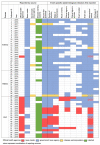Digital Biosurveillance for Zoonotic Disease Detection in Kenya
- PMID: 34206236
- PMCID: PMC8308926
- DOI: 10.3390/pathogens10070783
Digital Biosurveillance for Zoonotic Disease Detection in Kenya
Abstract
Infectious disease surveillance is crucial for early detection and situational awareness of disease outbreaks. Digital biosurveillance monitors large volumes of open-source data to flag potential health threats. This study investigates the potential of digital surveillance in the detection of the top five priority zoonotic diseases in Kenya: Rift Valley fever (RVF), anthrax, rabies, brucellosis, and trypanosomiasis. Open-source disease events reported between August 2016 and October 2020 were collected and key event-specific information was extracted using a newly developed disease event taxonomy. A total of 424 disease reports encompassing 55 unique events belonging to anthrax (43.6%), RVF (34.6%), and rabies (21.8%) were identified. Most events were first reported by news media (78.2%) followed by international health organizations (16.4%). News media reported the events 4.1 (±4.7) days faster than the official reports. There was a positive association between official reporting and RVF events (odds ratio (OR) 195.5, 95% confidence interval (CI); 24.01-4756.43, p < 0.001) and a negative association between official reporting and local media coverage of events (OR 0.03, 95% CI; 0.00-0.17, p = 0.030). This study highlights the usefulness of local news in the detection of potentially neglected zoonotic disease events and the importance of digital biosurveillance in resource-limited settings.
Keywords: Kenya; biosurveillance; digital surveillance; disease taxonomy; open-source information; zoonosis.
Conflict of interest statement
The authors do not have any conflict of interest to declare.
Figures
References
-
- Murray J., Cohen A.L. International Encyclopedia of Public Health. Elsevier Inc.; Amsterdam, The Netherlands: 2016. Infectious Disease Surveillance; pp. 222–229.
LinkOut - more resources
Full Text Sources


